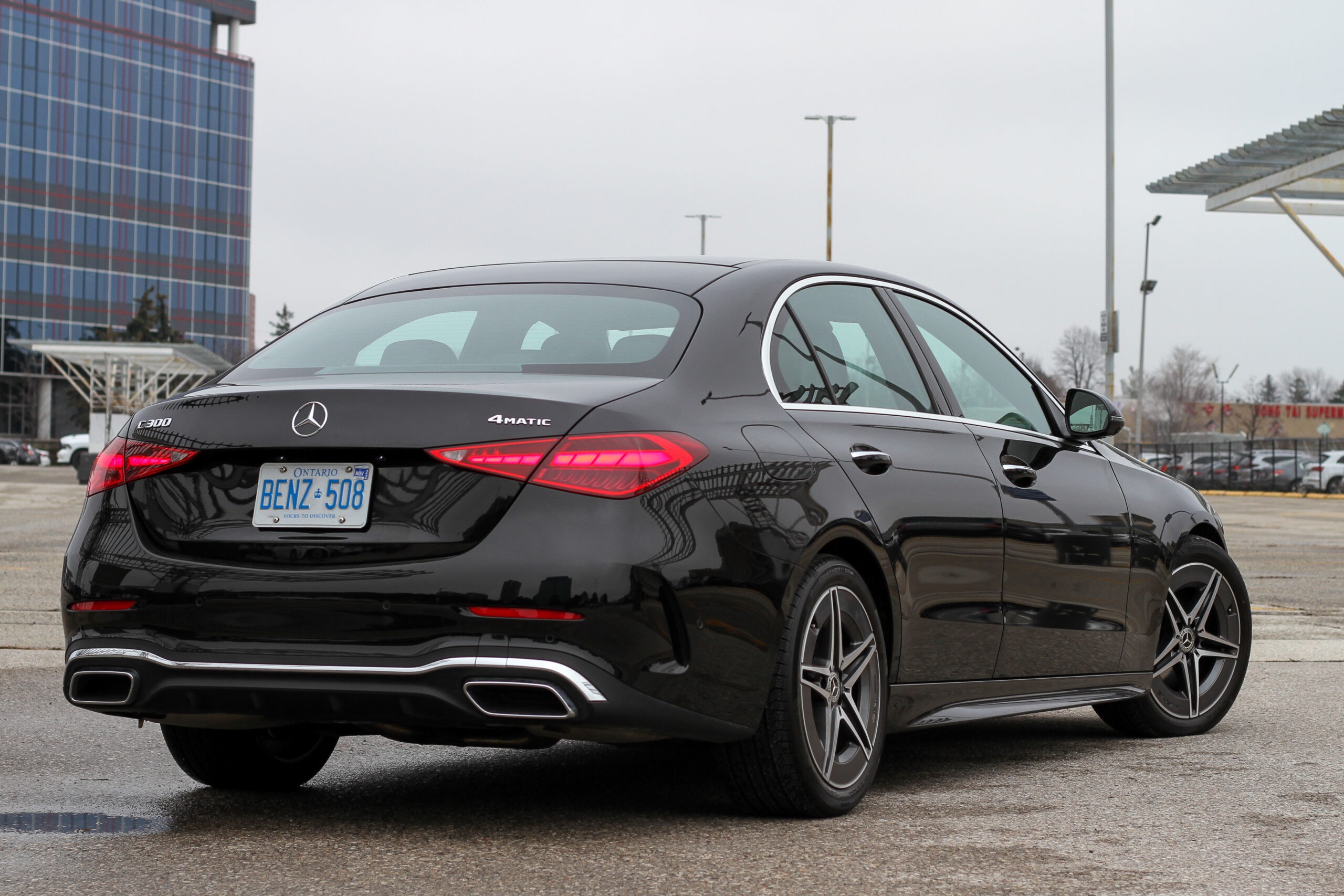The Mercedes-Benz C-Class has long been a benchmark in the compact luxury sedan segment. For decades, it’s represented attainable luxury and sophisticated engineering for aspiring professionals and discerning drivers alike. Now in its fifth generation, the 2022 Mercedes-Benz C300 aims to continue this legacy, blending opulent appointments with engaging performance. Having spent considerable time evaluating this vehicle, we delve into a comprehensive Mercedes C300 Review to determine if it lives up to the hype and if it deserves your consideration in a competitive market.
2022 Mercedes-Benz C300: Key Specifications
Before we dive deeper into the driving dynamics and interior ambiance, let’s outline the core specifications of the 2022 Mercedes-Benz C300 4Matic, as tested:
- Base Price (as tested): $46,600 ($55,200)
- Engine: 2.0-liter Turbocharged Four-Cylinder with 48-Volt Mild Hybrid System
- Transmission: 9-Speed Automatic
- Drivetrain: All-Wheel Drive (4Matic)
- Horsepower: 255 hp @ 5,800 rpm (plus 27 hp overboost)
- Torque: 295 lb-ft @ 2,000 to 3,200 rpm
- Curb Weight: 3,957 lbs
- Seating Capacity: 5
- Cargo Volume: 17.9 cubic feet
- Fuel Economy (EPA est.): 23 mpg City / 33 mpg Highway / 27 mpg Combined
- Verdict: A luxurious and refined compact sedan with a comfortable ride and an upscale interior, though marred by some usability quirks.
- Rating: 7.5/10
The Mercedes-Benz C-Class Legacy: Evolving Luxury
The C-Class has been a cornerstone of the Mercedes-Benz lineup since the early 1990s. While models like the A-Class and GLA now occupy the true entry-level positions, the C-Class remains the quintessential Mercedes for many. It’s the vehicle that often springs to mind when envisioning a Mercedes-Benz, particularly for those moving up the professional ladder. It competes head-to-head with established rivals such as the BMW 3 Series, Audi A4, and Lexus IS, each vying for the attention of luxury sedan buyers. The 2022 model year marks a significant shift, representing the fifth generation C-Class with a complete redesign aimed at modernizing and elevating its status.
From an exterior styling perspective, the 2022 C300 exudes a mature and understated elegance. Apart from the slightly more aggressive AMG Line grille, the design is intentionally subtle, avoiding unnecessary flashiness. It’s a car that projects sophistication without shouting for attention – a welcome contrast to some of its more overtly styled competitors. Compared to the bolder designs of the BMW 4 Series or the intricate lines of Lexus models, the C300 offers a breath of fresh, restrained air. This design language speaks to a buyer who values timeless style over fleeting trends.
Stepping inside the new C300 is where the vehicle truly shines. The interior is arguably its most compelling feature. The design, the quality of materials, and the overall ambiance create a truly luxurious and inviting space. Spending a week in this cabin is genuinely a pleasurable experience. It feels special and meticulously crafted, arguably surpassing the interiors of its BMW and Lexus rivals in perceived luxury and tactile satisfaction. The dual screens – a 12.3-inch digital instrument cluster and a driver-focused 11.9-inch central touchscreen – are crisp, vibrant, and seamlessly integrated. The flat-bottom leather steering wheel, with its perforated grips, feels premium to the touch. The customizable ambient lighting adds another layer of personalization and sophistication to the cabin environment.
Practicality is also a strong suit. The rear seats offer commendable space for the compact sedan category. Visually, it appears more spacious than the Lexus IS, and specification checks confirm slightly better legroom and headroom compared to both the BMW 3 Series and Audi A4. This makes the C300 a genuinely usable vehicle for small families or those who frequently carry rear passengers.
Under the hood, the entire C-Class lineup has transitioned to four-cylinder engines. While higher-performance AMG variants with electrified powertrains are on the horizon, the initial offering is the C300. It’s powered by a 2.0-liter turbocharged four-cylinder engine, enhanced by a 48-volt mild-hybrid system. This combination produces 255 horsepower and 295 lb-ft of torque. An overboost function provides an additional 27 horsepower for short bursts of acceleration. While all-wheel drive (4Matic) is available, a rear-wheel-drive configuration is standard. Mercedes-Benz claims a 0-60 mph acceleration time of 5.9 seconds and a top speed of 130 mph for the C300, figures that are respectable for the class.
Driving Experience: Comfort and Refinement
The Mercedes-Benz C300 is not designed to be a track weapon, but rather a refined and comfortable daily driver. Its strengths lie in its smooth highway cruising and effortless urban maneuverability. The cabin is well-insulated from road and wind noise, creating a serene environment. Handling is predictable and responsive, inspiring confidence without demanding constant driver input. The steering weight is adjustable through different drive modes, but even in its sportier settings, it remains light and easy to manage, prioritizing ease of use over overtly sporty feedback. It’s a car that feels substantial and luxurious in its demeanor, without being cumbersome.
Despite being the base model, the C300’s engine delivers ample performance. Its torque output allows for brisk acceleration, feeling comparable to the Lexus IS350, which was previously the most potent IS variant. The engine is responsive and provides enough power for enjoyable driving. On winding roads, the C300 handles competently, going where you point it with minimal fuss. It’s a car that’s pleasantly agile and light on its feet, making everyday driving enjoyable. Overall, the driving experience is characterized by comfort, composure, and a sense of effortless luxury.
However, the C300 is not without its flaws. One significant drawback is the brake pedal feel. The brake pedal calibration is unusual and inconsistent. The initial pedal travel feels unresponsive, with minimal braking action, but then abruptly becomes overly sensitive towards the end of its travel. This results in a pedal that is both long in travel and jerky in response, a combination that can make smooth braking challenging. Even after a week of driving, achieving consistently smooth stops required conscious effort and finesse.
It’s worth noting that this brake pedal issue may be specific to the test vehicle. While not all reviews explicitly praise the C300’s brakes, the most pronounced complaints seem to originate from journalists who tested the same Obsidian Black Metallic vehicle from Mercedes-Benz’s Toronto press fleet. Therefore, it’s strongly recommended to test drive the vehicle yourself to assess the brake pedal feel, as individual experiences may vary.
Regardless of whether the brake issue is widespread or isolated, it’s an uncharacteristic oversight for Mercedes-Benz, a manufacturer known for its engineering and attention to detail, especially in fundamental controls like braking.
Highs and Lows: Interior Excellence vs. Control Frustrations
Mercedes-Benz’s modern cabin designs, with their emphasis on digital displays and ambient lighting, may not appeal to all traditionalists. However, the interior of the C300 is undeniably a highlight. The design, material quality, and overall comfort level are genuinely commendable and worthy of the Mercedes-Benz badge. Much of the interior design language is borrowed from the flagship S-Class, inheriting subtle luxury touches that elevate the C300’s cabin experience. Examples include the pressure-sensitive seat adjustment controls and the soft-close doors, features typically found in higher-segment vehicles.
Interior build quality represents a significant improvement over the previous-generation C-Class. While the previous model was prone to creaking plastics, the new C300 feels more solid and refined. Although not quite as robust as a Porsche interior, unwanted noises are minimal, especially considering the intricate design and numerous panel gaps inherent in modern car interiors.
However, the interior also presents a significant drawback: the touch-sensitive controls. This is arguably the second biggest flaw after the brake pedal. Virtually all steering wheel controls are touch-sensitive, including the volume adjustment, which utilizes a touch slider reminiscent of Honda’s systems from the mid-2010s – systems that were widely criticized for their lack of tactile feedback and usability. Mercedes-Benz has opted for a similar approach, and it suffers from the same issues. The center console also lacks a traditional rotary knob, replaced by semi-touch-sensitive buttons that require excessive attention to operate accurately. Furthermore, all climate control functions are integrated into the touchscreen, requiring drivers to take their eyes off the road to adjust basic settings.
Another usability quirk is the heated steering wheel control. Activating or deactivating it requires either using voice commands via MBUX or engaging the heated seats, which automatically activates the heated steering wheel in tandem. This lack of a dedicated physical button or straightforward menu access is an unnecessary complication. Lastly, the base stereo system in the tested vehicle was deemed to be just adequate, suggesting that audiophiles will likely need to opt for an upgraded sound system.
Features, Options, and Market Competition
The 2022 Mercedes-Benz C300 4Matic starts at $46,600 in the US market. Choosing rear-wheel drive can save approximately $2,000. Equipment packaging varies between countries, but configuring a US-spec model to closely match the Canadian-spec test vehicle results in a price of around $55,200. The test vehicle, as driven in Canada, included the Sport Package ($2,300 CAD), Obsidian Black Metallic paint ($890 CAD), and had a total price of $60,365 CAD.
In terms of direct competition, the BMW 330i xDrive starts at $46,795, and the Audi A4 45 TFSI begins at $43,495. The C300 is the newest design among these three as of this review. Objectively assessing which is “best” is challenging, as each has its strengths and weaknesses. While the Mercedes-Benz boasts a particularly attractive interior, it arguably lags behind in user-friendliness due to its control interface. From a driving dynamics perspective, the C300 is likely comparable to the Audi A4, while the BMW 3 Series is often considered the most driver-focused, albeit potentially at the expense of some comfort.
Sustainability and Fuel Efficiency
The C300’s mild-hybrid system is primarily designed to enhance the smoothness of the automatic start-stop function, which it achieves effectively. The engine restarts are virtually imperceptible, minimizing disruptions to the driving experience. The EPA fuel economy ratings for the AWD C300 are 23 mpg city, 33 mpg highway, and 27 mpg combined. These figures are slightly less fuel-efficient than its BMW and Audi rivals. Real-world testing over approximately 350 miles of mixed driving confirmed the EPA combined estimate, with an observed fuel economy of 27 mpg.
Value Proposition and Final Verdict
The 2022 Mercedes-Benz C300, priced competitively within its segment, presents a somewhat mixed bag. Aside from the frustrating touch controls and the potentially problematic brake pedal, it’s a genuinely luxurious and enjoyable entry-level luxury sedan. It offers competent handling, sufficient power for everyday driving, and a beautifully appointed interior, all wrapped in a tastefully understated exterior design.
If you are drawn to the C300’s aesthetics, luxurious feel, and overall driving character – and many will be – the control interface and brake pedal are not insurmountable deal-breakers. However, they do detract from the overall experience. Navigating stoplights smoothly and adjusting basic functions without distraction requires more concentration than it should in a modern luxury vehicle.
Addressing these two key issues would elevate the C-Class to a highly recommended vehicle. The brake pedal feel may be a calibration issue or a first-year production anomaly, potentially resolvable. The touch controls represent a broader industry trend, and while Volkswagen’s recent reversal on touch-sensitive steering wheel controls offers a glimmer of hope, the future of Mercedes-Benz’s control interface remains uncertain. Despite these drawbacks, the core attributes of the new C-Class are compelling, preventing it from being dismissed outright.
Overall, the 2022 Mercedes-Benz C300 offers a compelling blend of luxury, comfort, and style. However, potential buyers should be aware of the usability challenges posed by the touch-sensitive controls and the need to thoroughly test drive the vehicle to assess the brake pedal feel before making a purchase decision.

